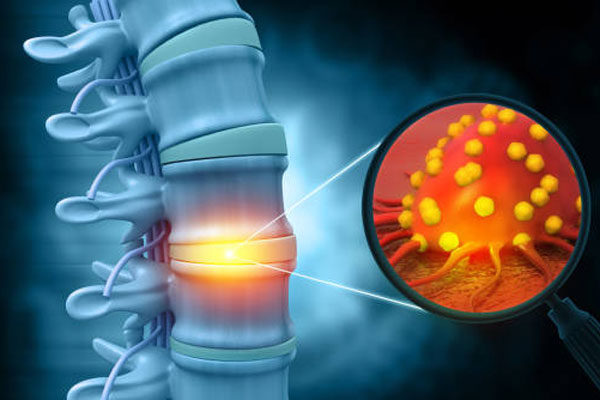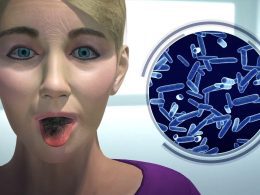Understanding Cancers of Bones and Joints:
Understanding cancers of bones and joints is crucial for comprehending the complexities and challenges associated with these malignancies. Bone and joint cancers, though relatively rare compared to other cancer types, can impact the structural integrity and function of the skeletal system. These cancers may arise from bone cells or soft tissues surrounding the joints, leading to symptoms such as persistent pain, swelling, and restricted mobility. Early detection through imaging, biopsy, and consultation with medical specialists is pivotal for accurate diagnosis and timely intervention. Treatment approaches may involve a combination of surgery, chemotherapy, and radiation therapy tailored to the specific characteristics of the bone or joint cancer, highlighting the importance of a multidisciplinary approach in managing these conditions.

Most Common Types of Primary Cancers
- Osteosarcoma
- Ewing sarcoma
- Chondrosarcoma
Osteosarcoma
Osteosarcoma (also called osteogenic sarcoma) is the most common type of cancer that starts in the bones. The cancer cells in these tumors look like early forms of bone cells that normally help make new bone tissue, but the bone tissue in an osteosarcoma is not as strong as that in normal bones.
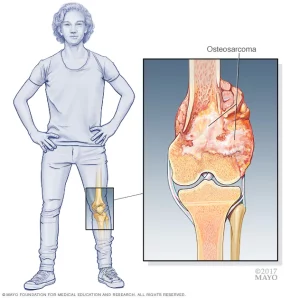
Warning Signs
- A bump, depending on where the tumor is located.
- Redness and warmth at the site of the tumor.
- Anemia.
- Fever.
- Exhaustion.
- Unexplained weight loss.
Causes of Osteosarcoma
Can osteosarcoma be cured?
Ewing sarcoma:
Ewing sarcoma is a type of cancer that begins as a growth of cells in the bones and the soft tissue around the bones. Ewing (Yoo-ing) sarcoma mostly happens in children and young adults, although it can happen at any age.
Ewing sarcoma most often begins in the leg bones and in the pelvis, but it can happen in any bone. Less often, it starts in the soft tissues of the chest, abdomen, arms or other locations.
Ewing sarcoma signs and symptoms typically start in and around a bone. This cancer most often affects bones in the legs and the pelvis.
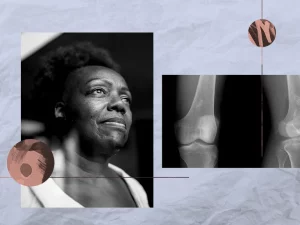
Warning Signs
When symptoms happen in and around a bone, they might include:
- A lump in the arm, leg, chest or pelvis.
- Bone pain.
- Break in a bone, also called a fracture.
- Pain, swelling or tenderness near the affected area.
Sometimes Ewing sarcoma causes symptoms that affect the whole body. These can include:
- Fever.
- Losing weight without trying.
- Tiredness.
Causes of Ewing sarcoma:
It is not clear what causes Ewing sarcoma.
Ewing sarcoma happens when cells develop changes in their DNA. A cell’s DNA holds the instructions that tell a cell what to do. In healthy cells, the DNA gives instructions to grow and multiply at a set rate. The instructions tell the cells to die at a set time.
In cancer cells, the DNA changes give different instructions. The changes tell the cancer cells to make many more cells quickly. Cancer cells can keep living when healthy cells would die.
The cancer cells might form a mass called a tumor. The tumor can grow to invade and destroy healthy body tissue. In time, cancer cells can break away and spread to other parts of the body. When cancer spreads, it is called metastatic cancer.
In Ewing sarcoma, the DNA changes most often affect a gene called EWSR1. If your healthcare professional suspects that you or your child has Ewing sarcoma, the cancer cells may be tested to look for changes in this gene.
Can Ewing sarcoma be cured?
In children and adolescents, oncologists typically prescribe a combination of five drugs given in an alternating order for up to a year. This combination therapy is able to cure around 70% of young patients with localized disease.
Chondrosarcoma:
Chondrosarcoma is a type of bone cancer that starts in cartilage cells. Cartilage is the smooth connective tissue that protects the ends of bones and lines most joints. Chondrosarcoma is the second most common type of primary bone cancer in adults. The exact cause is not known.
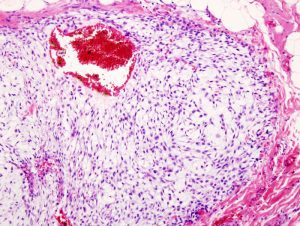
Warning Signs
Chondrosarcomas may not cause symptoms until they’ve grown large enough to affect nearby tissues. At that point, you may experience:
- Persistent pain that slowly worsens over time—potentially requiring increasing amounts of pain medication
- Pain that may occur at night
- Limited range of motion for tumors near joints
- Slowly enlarging, firm mass occurring over months or years without evaluation and treatment
Depending on their location, chondrosarcomas can also push on nerves or organs. Tumors in the pelvis or spine can lead to pain, numbness, tingling, bowel or bladder problems, or muscle weakness.
Causes of Ewing sarcoma:
The result is an abnormal gene that can be detected with DNA testing. It is not known why the Ewing sarcoma translocation occurs. The cause of Ewing sarcoma is genetic — in that it comes from genetic changes in tumor cells — but it is not inherited like some other childhood cancers.
Can Chondrosarcoma be Cured?
Conclusion
In conclusion, understanding cancers of bones and joints is paramount for early detection, accurate diagnosis, and effective management of these relatively uncommon yet impactful malignancies. The intricate nature of bone and joint cancers necessitates a multidisciplinary approach involving medical specialists and tailored treatment strategies. Recognizing the symptoms, such as persistent pain and swelling, prompts timely medical attention, enabling interventions that can preserve structural integrity and improve outcomes. Ongoing research and advancements in cancer care contribute to enhanced understanding and evolving treatment options, underscoring the significance of awareness, early intervention, and collaborative medical efforts in addressing cancers affecting the skeletal system.






